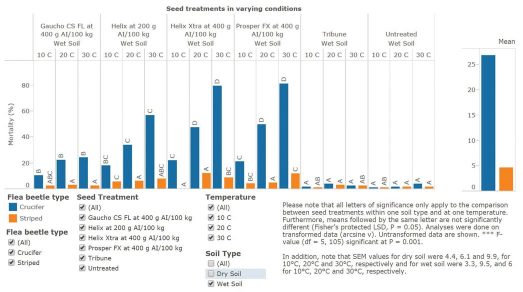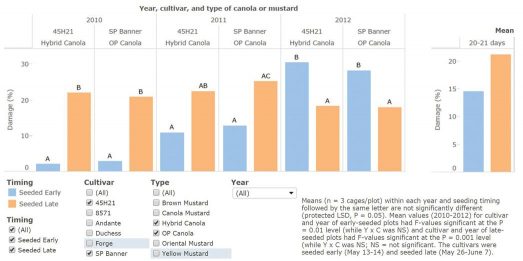Flea beetle management
Crucifer flea beetle and striped flea beetle are significant pests to western Canadian canola. Economic impact on crop production varies with population densities, and the two species react quite differently to their environment. This is especially noticeable in their response to neonicotinoid seed treatment, with striped flea beetles less susceptible to control. Yield losses of about 10 per cent are common where flea beetles are abundant, even when the crop is protected with insecticides.
‘Mitigation of Risk to Canola from Spring Flea Beetle Injury’ was a three-year study led by Juliana Soroka with Agriculture and Agri-Food Canada (AAFC) to investigate differences in the biology of striped and crucifer flea beetles and target better management methods. Objectives were to: 1) determine factors affecting distribution, spring emergence, flight and feeding levels, and 2) investigate reasons for seed treatment failures and alternatives for flea beetle control.
Emergence timing was found to be inconsistent, with striped flea beetles typically emerging first in the spring and active at temperatures lower than crucifer species. Both species are more likely to fly from field to field when temperatures exceed 15°C. Crucifer flea beetle flight height decreased with increases in relative humidity and damage to canola cotyledons from both species increased as the temperature increased. As a result, Soroka recommends that producers inspect canola daily when temperatures reach 20 to 25°C.

on hybrid canola in wet soil at 10, 20 and 30°C. This table, shown as it appears on the Canola Research Hub at canolaresearch.ca, illustrates the effect of tested neonicotinoid seed treatments on flea beetle mortality by species, at varying temperatures and in wet or dry soil conditions. Click to see the full-size graph.
Seed treatment issues for flea beetle control
Soroka and her team used growth chamber experiments and field trials to determine the effects of temperature and soil moisture on the toxicity of neonicotinoid seed treatments to striped and crucifer flea beetles.
They found these treatments to provide substantially better control and protection against crucifer flea beetles than the striped species. (See Table 1.) Therefore, seed treatment failures are more likely to occur when striped flea beetles are the most abundant. Failures were also found to be more likely
with above-average rainfall and high temperatures (20 to 30°C) during germination and seedling emergence.
A second study led by Soroka, ‘Potential Flea Beetle Species Composition Shift in Prairie Canola’, shows that although the crucifer flea beetle remains the predominant species, especially in those fields where flea beetle numbers are particularly high, the striped flea beetle is expanding its range across Western Canada. The striped species is now the most frequently encountered flea beetle in the Peace River Region and central Alberta, central Saskatchewan and much of Manitoba. Spring scouting is critical to planning proper control strategies.
Effect of Seeding Date
Flea beetles were also studied as part of another AAFC project led by Owen Olfert and Bob Elliott – ‘Detection, Surveillance and Management of Weed, Insect and Disease Pests that Threaten the Economic Viability of Crop Production and the Environmental Health of Prairie Agro-Ecosystems’.
Over three test years, flea beetle damage to canola was found to be lower in early-seeded plots (14.6 per cent) than in late-seeded plots (21.4 per cent) (see Table 2). Early seeding also improved canola yields by 12 per cent and the crucifer to striped species population shift was confirmed with a greater shift seen in early-seeded plots than in late-seeded plots.

Emergence of crucifer and striped flea beetles from early- and late-seeded canola varied yearly depending on the species, planting date and temperature. Striped flea beetles emerged two to three weeks earlier than crucifer flea beetles. Both species emerged one to five days sooner in early-seeded canola than in late-seeded canola and also emerged earlier in years with above-average temperatures than in years with below-average temperatures.
Consistent with other studies, Olfert and Elliott’s field trials suggest that more effective seed treatments are needed for flea beetle control when cool, moist conditions prevail after seeding. Neonicotinoid seed treatments provide limited agronomic benefit when flea beetle damage is low and rainfall is above average throughout most of the growing season.
More details on these findings, and an expanding library of many more, can be found at the Canola Research Hub online at canolaresearch.ca.





